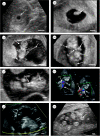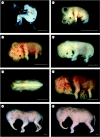Foetal age determination and development in elephants
- PMID: 17164195
- PMCID: PMC1702383
- DOI: 10.1098/rspb.2006.3738
Foetal age determination and development in elephants
Abstract
Elephants have the longest pregnancy of all mammals, with an average gestation of around 660 days, so their embryonic and foetal development have always been of special interest. Hitherto, it has only been possible to estimate foetal ages from theoretical calculations based on foetal mass. The recent development of sophisticated ultrasound procedures for elephants has now made it possible to monitor the growth and development of foetuses of known gestational age conceived in captivity from natural matings or artificial insemination. We have studied the early stages of pregnancy in 10 captive Asian and 9 African elephants by transrectal ultrasound. Measurements of foetal crown-rump lengths have provided the first accurate growth curves, which differ significantly from the previous theoretical estimates based on the cube root of foetal mass. We have used these to age 22 African elephant foetuses collected during culling operations. Pregnancy can be first recognized ultrasonographically by day 50, the presumptive yolk sac by about day 75 and the zonary placenta by about day 85. The trunk is first recognizable by days 85-90 and is distinct by day 104, while the first heartbeats are evident from around day 80. By combining ultrasonography and morphology, we have been able to produce the first reliable criteria for estimating gestational age and ontological development of Asian and African elephant foetuses during the first third of gestation.
Figures



References
-
- Allen W.R. Ovulation, pregnancy, placentation and husbandry in the African elephant (Loxodonta africana) Phil. Trans. R. Soc. B. 2006;361:821–834. doi:10.1098/rstb.2006.1831 - DOI - PMC - PubMed
-
- Allen W.R, Mathias S, Wooding F.B, van Aarde R.J. Placentation in the African elephant (Loxodonta africana): II Morphological changes in the uterus and placenta throughout gestation. Placenta. 2003;24:598–617. doi:10.1016/S0143-4004(03)00102-4 - DOI - PubMed
-
- Amoroso E.C, Perry J.S. The foetal membranes and placenta of the African elephant (Loxodonta africana) Phil. Trans. R. Soc. B. 1964;248:1–34.
-
- Brown J.L, Walker S, Moeller T. Comparative endocrinology of cycling and non-cycling Asian (Elephas maximus) and African (Loxodonta africana) elephants. Gen. Comp. Endocrinol. 2004;136:360–370. doi:10.1016/j.ygcen.2004.01.013 - DOI - PubMed
-
- Craig G.C. Foetal mass and date of conception in African elephants: a revised formula. S. Afr. J. Sci. 1984;80:512–516.
Publication types
MeSH terms
LinkOut - more resources
Full Text Sources

